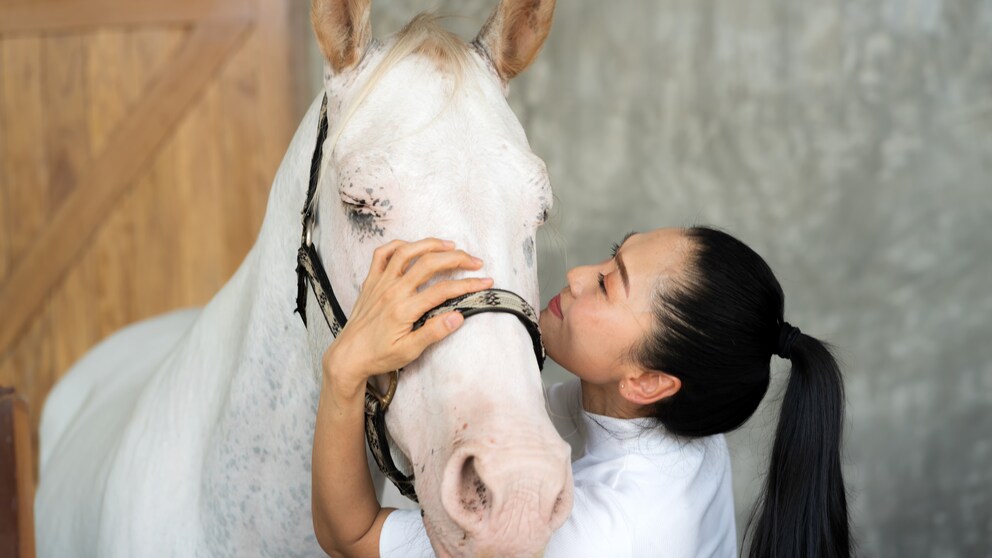July 5, 2024, 5:11 am | Read time: 4 minutes
Sun protection is not only important for humans; it is also important for horses, as they too can get a sunburn. In this overview, PETBOOK reveals what horse owners and riders can do to protect their horses in the summer months.
Hours of grazing in the pastures, long rides through the woods and meadows, or simply being ridden on the riding ground – in the spring and summer months, weather conditions are often ideal for horses and humans. However, the increasing intensity of the sun can also be dangerous for riders and horses alike. If horses and ponies are not stabled for most of the day or have sufficient shade in the paddock, they end up getting a lot of sun throughout the day without protection. And this can have consequences for the horses, especially sunburn.
What sunburn on horses looks like
Sunburn on horses looks similar to sunburn on humans. The following symptoms are clear signs that the horse is sunburned:
- red skin
- swollen skin
- the skin is sensitive to pressure
- burn blisters can occur in cases of severe burns
Some owners only notice the sunburn when grooming, saddling, or bridling the horse because it reacts sensitively to touch or even avoids it.
These horses are particularly susceptible to sunburn
Fair-skinned people need to protect themselves particularly well from getting sunburned in the summer. This is because less of the skin-coloring substance melanin, is present in fairer-skinned individuals, giving them less protection against UV radiation. This is similar for horses, although the combination of skin and coat color is also an important factor. Many light-colored and white horses often have pink skin that has little or no melanin and, therefore, hardly any protection against the sun’s rays. Their coat is particularly thin on the nostrils and muzzle; therefore, the pink skin shows through. These areas are very susceptible to sunburn.
The withers and root of the tail are often called “sun terraces”. This is because a large amount of sunlight reaches these areas. “True” gray horses, i.e., those with a dark or even black coat at birth, usually also have dark skin and are therefore not particularly at risk. An exception to this is the large white markings on the heads or legs of all horses. These areas also react very sensitively to sunlight.
Incidentally, even if horses with black or dark coats are less susceptible to sunburn, they quickly suffer from overheating as their coat color causes them to heat up quickly in the sun. These horses also need shady areas and sufficient water.
Avoiding sunburn in horses
Some parallels can also be drawn with humans when it comes to sun protection. Paddocks and runs should have plenty of shady areas. Large deciduous trees are ideal, as it is cooler under them on hot summer days. Oaks should be avoided because of the oak processionary moth and its burning hairs. Alternatively, an open stable or other shelter that provides sufficient shade for all horses is a good option.
In addition to avoiding direct sunlight, there are also some tools available. For example, riding suppliers offer sun lotion made for horses. If you don’t have any at hand, you can also use children’s sun cream. Important: It should always be fragrance-free. There are also special, thin horse blankets that have a sun protection factor. Fly nets for the muzzle or head often come equipped with UV protection. Hoof boots are ideal for light-colored markings on the legs or over the hooves.
Treating a horse’s burnt skin
If the horse gets a sunburn despite all precautionary measures or because of a lack of knowledge, the first thing to do is to take it out of the sun. If the burned area of skin gets more sun, severe inflammation can develop, followed by scarring. This also increases their risk of skin cancer.
In addition to a shady spot, sunburned horses prefer to have the affected areas of their skin cooled. Cold water can help initially as well as repeatedly if the weather is hot. A zinc ointment is suitable for drying weeping burns; a wound ointment may also be applied.

Don Sphynx – Character and Attitude of the Demanding Naked Cat

Why Animal Lovers Should Not Get an Elf Cat


